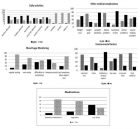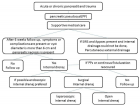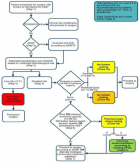Abstract
Research Article
Alternate day outpatient hemodialysis schedule is the appropriate practical alternative schedule to improve patients’ outcomes
Nasrulla Abutaleb*
Published: 27 June, 2019 | Volume 3 - Issue 2 | Pages: 107-110
The rise in all-cause and cardiovascular mortality and hospitalization rates among the hemodialysis (HD) patients after the long weekly inter-dialysis interval is very impressive. In fact, there is an additional long-term morbidity risk besides this acute rise in mortality and hospitalizations that can be expected from the weakly exaggerated pre-dialysis peaks of the less risky hemodynamic and biochemical parameters. An approach for eliminating these long weekend inter-dialysis intervals is through the provision of the hemodialysis sessions on every other day (EOD) basis, regardless of the week days. This is likely to be both practical and cost-effective. Such EOD schedule can be introduced easily beside the ongoing thrice weekly HD schedule without disturbance of the HD unit work. The availability of EOD schedule would provide a healthier and cost-effective alternative schedule for those patients who can’t tolerate the weekend intervals and for those looking for maintaining their long-term health on the option of hemodialysis. In fact, with available data, medical staff is expected to encourage all patients to shift their HD to the EOD schedule.
Read Full Article HTML DOI: 10.29328/journal.jcn.1001034 Cite this Article Read Full Article PDF
References
- Foley RN, Gilbertson DT, Murray T. Long Interdialytic Interval and Mortality among Patients Receiving Hemodialysis. N Engl J Med. 2011; 365: 1099-1107. Ref.: https://bit.ly/2NfLiH9
- Zhang H, Schaubel DE, Kalbfleisch JD. Dialysis outcomes and analysis of practice patterns suggests the dialysis schedule affects day-of-week mortality. Kidney Int. 2012; 81: 1108–1115. Ref.: https://bit.ly/2IR7LpE
- Springel T, Laskin B, Shult J. Longer interdialytic interval and cause-specific hospitalization in children receiving chronic dialysis. Nephrol Dial Transplant. 2013; 28: 2628–2636. Ref.: https://bit.ly/2NcLBSW
- Hakmei EJ, Nietert PJ, Fitzgibbon WR. Length of Interdialytic Intervals Affects Morbidity and Mortality in Chronic Haemodialysis Patients. J Clin Exp Nephrol. 2017: 2: 38. Ref.: https://bit.ly/2Nhxegn
- US Renal Data System. USRDS 2013 Annual Data Report: Atlas of Chronic Kidney Disease & End-Stage Renal Disease in the United States. Bethesda, MD, National Institutes of Health. National Institute of Diabetes and Digestive and Kidney Diseases. 2013.
- Georgianos PI, Sarafidis PA, Sinha AD. Adverse Effects of Conventional Thrice-Weekly Hemodialysis: Is It Time to Avoid 3-Day Interdialytic Intervals? Am J Nephrol. 2015; 41: 400–408. Ref.: https://bit.ly/2IQOmW0
- Georgianos PI, Sarafidis PA, Haidich AB. Diverse effects of interdialytic intervals on central wave augmentation in hemodialysis patients. Nephrol Dial Transplant. 2013; 28: 2160-2169. Ref.: https://bit.ly/2NfNf6r
- Obokata M, Negishi K, Marwick TH. Comparison of different interdialytic intervals among hemodialysis patients on their echocardiogram-based cardiovascular parameters, American Heart Journal. 2015; 169: 523-530. Ref.: https://bit.ly/2xg1PQE
- Leggat JE, Orzol SM, Hulbert-Shearon TE, Golper TA, Jones CA. Noncompliance in hemodialysis: Predictors and survival analysis. AJKD. 1998; 32: 139-145. Ref.: https://bit.ly/2RLQwJr
- Saran R, Bragg-Gresham JL, Rayner HC. Nonadherence in hemodialysis: Associations with mortality, hospitalization, and practice patterns in the DOPPS. Kidney International. 2003; 64: 254–262. Ref.: https://bit.ly/2KHaPqo
Similar Articles
-
The Risk-Adjusted Impact of Intraoperative Hemofiltration on Real-World Outcomes of Patients Undergoing Cardiac SurgeryMatata BM*,Shaw M. The Risk-Adjusted Impact of Intraoperative Hemofiltration on Real-World Outcomes of Patients Undergoing Cardiac Surgery. . 2017 doi: 10.29328/journal.jcn.1001001; 1: 001-010
-
Cardiac Manifestations on Anti-Phospholipid SyndromeFaisal AH*. Cardiac Manifestations on Anti-Phospholipid Syndrome. . 2017 doi: 10.29328/journal.jcn.1001002; 1: 011-013
-
Intraperitoneal and Subsequent Intravenous Vancomycin: An Effective Treatment Option for Gram-Positive Peritonitis in Peritoneal DialysisBarone RJ*,Gimenez NS,Ramirez L. Intraperitoneal and Subsequent Intravenous Vancomycin: An Effective Treatment Option for Gram-Positive Peritonitis in Peritoneal Dialysis. . 2017 doi: 10.29328/journal.jcn.1001003; 1: 014-018
-
Acute Tubulointerstitial Nephritis due to Phenytoin: Case ReportNilzete Liberato Bresolin*,Pedro Docusse Junior,Maria Beatriz Cacese Shiozawa,Marina Ratier de Brito Moreira,Natalia Galbiatti Silveira. Acute Tubulointerstitial Nephritis due to Phenytoin: Case Report. . 2017 doi: 10.29328/journal.jcn.1001004; 1: 019-025
-
Profile of vitamin D receptor polymorphism Bsm I and FokI in end stage renal disease Egyptian patients on maintenance hemodialysisEL-Attar HA*,Mokhtar MM,Gaber EW. Profile of vitamin D receptor polymorphism Bsm I and FokI in end stage renal disease Egyptian patients on maintenance hemodialysis. . 2017 doi: 10.29328/journal.jcn.1001005; 1: 026-040
-
Anemia response to Methoxy Polyethylene Glycol-Epoetin Beta (Mircera) versus Epoetin Alfa (Eprex) in patients with chronic Kidney disease on HemodialysisAlaa K Dhayef*,Jawad K Manuti,Abdulwahab S Abutabiekh. Anemia response to Methoxy Polyethylene Glycol-Epoetin Beta (Mircera) versus Epoetin Alfa (Eprex) in patients with chronic Kidney disease on Hemodialysis. . 2017 doi: 10.29328/journal.jcn.1001006; 1: 041-047
-
The outcome of Acute Kidney Injury in patients with severe MalariaJoão Egidio Romão Jr*,João Alberto Brandão. The outcome of Acute Kidney Injury in patients with severe Malaria. . 2017 doi: 10.29328/journal.jcn.1001007; 1: 048-054
-
Short term effect of Intravenous Intermittent Iron Infusion versus Bolus Iron Infusion on Iron parameters in Hemodialysis patientsIman Ibrahim Sarhan,Hussein Sayed Hussein,Islam Omar Elshazly*,Mahmoud Salah Hassan. Short term effect of Intravenous Intermittent Iron Infusion versus Bolus Iron Infusion on Iron parameters in Hemodialysis patients. . 2017 doi: 10.29328/journal.jcn.1001008; 1: 055-059
-
Association between bh4/bh2 ratio and Albuminuria in Hypertensive Type -2 Diabetic patientsJose Aviles-Herrera,Karla C Arana-Pazos,Leonardo Del Valle-Mondragon,Carolina Guerrero-García,Alberto Francisco Rubio-Guerra*. Association between bh4/bh2 ratio and Albuminuria in Hypertensive Type -2 Diabetic patients. . 2017 doi: 10.29328/journal.jcn.1001009; 1: 060-063
-
Posterior Reversible Leukoencephalopathy Syndrome in a patient after second dose of Rituximab for treatment of resistant Thrombotic Thrombocytopenic PurpuraSabaa Asif*,Sumbal Nasir Mahmood,Osama Kunwer Naveed. Posterior Reversible Leukoencephalopathy Syndrome in a patient after second dose of Rituximab for treatment of resistant Thrombotic Thrombocytopenic Purpura . . 2018 doi: 10.29328/journal.jcn.1001010; 2: 001-004
Recently Viewed
-
Sinonasal Myxoma Extending into the Orbit in a 4-Year Old: A Case PresentationJulian A Purrinos*, Ramzi Younis. Sinonasal Myxoma Extending into the Orbit in a 4-Year Old: A Case Presentation. Arch Case Rep. 2024: doi: 10.29328/journal.acr.1001099; 8: 075-077
-
Improvement of the Cognitive Abilities in a Chronic Generalized Anxiety Disorder and Moderate Depression Case using a Novel Integrated Approach: The Cognitome ProgramMohita Shrivastava*. Improvement of the Cognitive Abilities in a Chronic Generalized Anxiety Disorder and Moderate Depression Case using a Novel Integrated Approach: The Cognitome Program. J Neurosci Neurol Disord. 2024: doi: 10.29328/journal.jnnd.1001100; 8: 069-089
-
Neuroprotective Effect of 7,8-dihydroxyflavone in a Mouse Model of HIV-Associated Neurocognitive Disorder (HAND)Tapas K Makar, Joseph Bryant, Bosung Shim, Kaspar Keledjian, Harry Davis, Manik Ghosh, Ajay Koirala, Ishani Ghosh, Shreya Makar, Alonso Heredia, Malcolm Lane, J Marc Simard, Robert C Gallo, Volodymyr Gerzanich*, Istvan Merchenthaler*. Neuroprotective Effect of 7,8-dihydroxyflavone in a Mouse Model of HIV-Associated Neurocognitive Disorder (HAND). J Neurosci Neurol Disord. 2024: doi: 10.29328/journal.jnnd.1001101; 8: 090-105
-
Adult Neurogenesis: A Review of Current Perspectives and Implications for Neuroscience ResearchAlex, Gideon S*,Olanrewaju Oluwaseun Oke,Joy Wilberforce Ekokojde,Tolulope Judah Gbayisomore,Martina C. Anene-Ogbe,Farounbi Glory,Joshua Ayodele Yusuf. Adult Neurogenesis: A Review of Current Perspectives and Implications for Neuroscience Research. J Neurosci Neurol Disord. 2024: doi: 10.29328/journal.jnnd.1001102; 8: 106-114
-
Analysis of Psychological and Physiological Responses to Snoezelen Multisensory StimulationLucia Ludvigh Cintulova,Jerzy Rottermund,Zuzana Budayova. Analysis of Psychological and Physiological Responses to Snoezelen Multisensory Stimulation. J Neurosci Neurol Disord. 2024: doi: 10.29328/journal.jnnd.1001103; 8: 115-125
Most Viewed
-
Evaluation of Biostimulants Based on Recovered Protein Hydrolysates from Animal By-products as Plant Growth EnhancersH Pérez-Aguilar*, M Lacruz-Asaro, F Arán-Ais. Evaluation of Biostimulants Based on Recovered Protein Hydrolysates from Animal By-products as Plant Growth Enhancers. J Plant Sci Phytopathol. 2023 doi: 10.29328/journal.jpsp.1001104; 7: 042-047
-
Sinonasal Myxoma Extending into the Orbit in a 4-Year Old: A Case PresentationJulian A Purrinos*, Ramzi Younis. Sinonasal Myxoma Extending into the Orbit in a 4-Year Old: A Case Presentation. Arch Case Rep. 2024 doi: 10.29328/journal.acr.1001099; 8: 075-077
-
Feasibility study of magnetic sensing for detecting single-neuron action potentialsDenis Tonini,Kai Wu,Renata Saha,Jian-Ping Wang*. Feasibility study of magnetic sensing for detecting single-neuron action potentials. Ann Biomed Sci Eng. 2022 doi: 10.29328/journal.abse.1001018; 6: 019-029
-
Pediatric Dysgerminoma: Unveiling a Rare Ovarian TumorFaten Limaiem*, Khalil Saffar, Ahmed Halouani. Pediatric Dysgerminoma: Unveiling a Rare Ovarian Tumor. Arch Case Rep. 2024 doi: 10.29328/journal.acr.1001087; 8: 010-013
-
Physical activity can change the physiological and psychological circumstances during COVID-19 pandemic: A narrative reviewKhashayar Maroufi*. Physical activity can change the physiological and psychological circumstances during COVID-19 pandemic: A narrative review. J Sports Med Ther. 2021 doi: 10.29328/journal.jsmt.1001051; 6: 001-007

HSPI: We're glad you're here. Please click "create a new Query" if you are a new visitor to our website and need further information from us.
If you are already a member of our network and need to keep track of any developments regarding a question you have already submitted, click "take me to my Query."

















































































































































